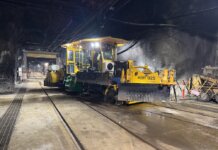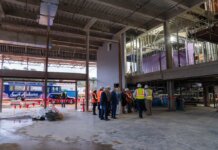
Very few aviation companies can boast 120 years of experience in the industry, especially since the Wright brothers only made their first flight 122 years ago. But Continental Aerospace Technologies, nestled in Mobile, can do just that, and much more.
Continental’s story began in Muskegon, Michigan, as Continental Motors. For more than half a century, Continental produced traditional piston-based engines for lighter personal aircraft, or “general aviation.”
In the late 1940s, the end of World War II saw the rapid expansion of the light airplane industry, and Continental grew with it. Continental continued to innovate, introducing general aviation to turbocharging and fuel injection in the early 1960s.
In 1964, Jerrie Mock completed the first solo flight around the world by a woman, a tremendous feat accomplished in a Cessna 180 aircraft powered by a Continental engine.
Continental’s demand eventually outpaced its capacity. The company needed a new home, and in 1966, they found one right here in Alabama.
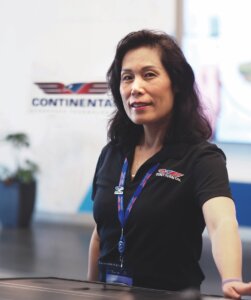
“We outgrew Muskegon,” says Karen Hong, Continental’s global CEO and president. “The story we’re told is [Brookley Air Force Base] closed down here and literally, we moved in the next day.”
In Hong’s view, Mobile was definitely the right place to relocate: “I think they made a good choice to anchor over here, because of the labor pool and the state and local leaders’ support.” Mobile’s port made it easy to move products and materials, and Alabama’s warm climate prevented the kind of costly cold weather delays that could vex northern cities. Mobile’s 11-building complex provided Continental with room for decades of operational expansion.
In 1999, Continental unveiled its innovative FADEC- equipped engine, or Fully Authorized Digital Engine Control. FADEC is a computer-guided engine control unit that elegantly combines throttle, prop and fuel mixture into a single control, providing optimal fuel efficiency at any altitude and thrust, while taking the mental burden off of pilots. Or, as Hong more pragmatically puts it: “You push one button, you relax, and you can talk.”
That convenience is no accident, as the pilot experience is a big part of Continental’s focus. For Continental’s employees and leadership, the versatility and freedom of general aviation is paramount.
“Once you discover Continental and the pride that the team members have and the love that we have for general aviation, we just want to share it with more people,” says Continental’s Marketing Director Andrea Bertagnolli. “Our industry is such a passion-driven industry. For some, they use [Continental planes] as a hobby on a weekend to be able to fly to an Alabama football game while others use it to travel to four cities in a day for business.”
Continental continued to grow in 2011, when it was acquired by a subsidiary of AVIC International, headquartered in Beijing, China. Access to larger supply chains and customer bases gave Continental the ability to spread its wings and become a true global competitor. Today, Continental supports customers in 78 countries from its three global offices: its headquarters in Mobile; a service and maintenance facility across Mobile Bay in Fairhope; and a major manufacturing facility for its Jet-A engine in St. Egidien, Germany.
While the 11-building complex in Mobile provided Continental with the room it needed to grow, it also had some downsides, specifically in efficiency: parts would have to be transported from building to building by hand or driven in carts for continued assembly, and employees in one building had little contact with employees in other buildings.
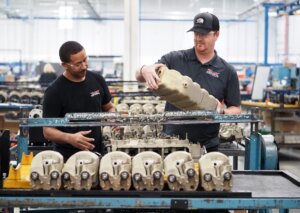
Eventually, Continental realized another change was needed: moving its global headquarters into one large facility. “And so again, we were trying to choose a new site. Where would we put our new global headquarters?” says Bertagnolli. “Were we going to move? What were we going to do? Obviously, there were other incentives from other local governments and things like that.”
But in the end, she says, the decision wasn’t a difficult one: “These people [of Mobile] are what make our engines and we’re nothing without them. So, for us, it was an easy decision to just move across the fence.”
And Continental did just that in 2018, building a new cutting-edge global headquarters and manufacturing facility just across the fence line from its previous location. The new 275,000-square-foot facility is a monument to efficiency, where cast and molded metal hunks, or ingots, start at one end of a huge indoor manufacturing floor, and slowly make their way from station to station, being heated, cooled, chipped away, milled, measured, plated, processed and assembled, until they reach the opposite end of the manufacturing floor as precisely engineered parts, or even fully assembled engines, ready to ship to customers.
Teams also communicate and relate with each other much more easily. Many teams hold open-air stand-up meetings right on the plant floor, and office workers who were once partitioned away in separate buildings — departments like human resources, sales support, housekeeping, corporate leadership and others — now work in open-design office spaces, which overlook the manufacturing floor through a near-continuous row of large windows.
Every detail of the building — from its company’s 120-year timeline proudly touted on the walls of its lobby to the vertical banners at each manufacturing station, adroitly detailing the part that is being built there and its purpose in the engine — works to foster collaboration and company cohesion.
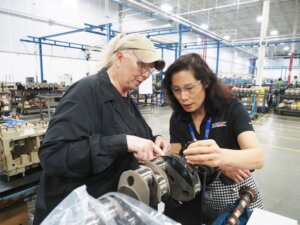
And that focus on people permeates Continental through to its development programs. “We have a Cornerstone people development system and also Continental Aerospace Technology Academy,” says Hong. “We can provide not only theory, but also hands-on opportunities.”
This academy, filled with classroom staples like desks and whiteboards as well as fully and partially assembled engines hoisted on stands, welcomes technicians and engineers from all over the world to train on maintaining Continental engines.
And Continental nurtures its employees’ love of general aviation with its Flying Club, a small stable of light aircraft for use by employees with enough tenure.
With that focus on connection, it’s no wonder many Continental employees are either private pilots or student pilots, including both Hong and Bertagnolli.
“It’s one of the most affordable ways that you can get your private pilot or further on training licenses,” says Bertagnolli. “The more that we can fly and spend time connected to our product and see what our customers are experiencing, it just helps make that customer connection.”
Steven Castle and Mike Kittrell are Mobile-based freelance contributors to Business Alabama.
This article appears in the October 2025 issue of Business Alabama.

